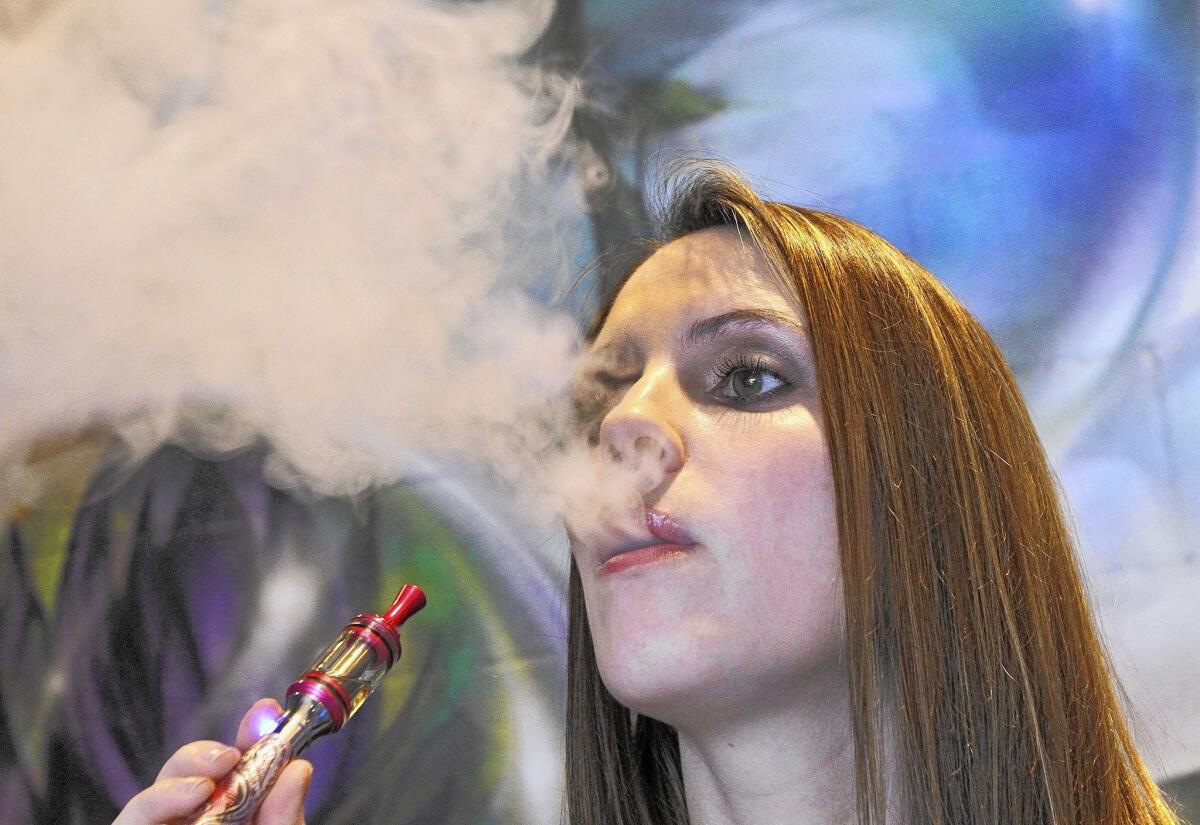Students say vaping is an easy habit to start

While the adult world rallies to regulate sales of e-cigarettes to minors and use of the devices among them, local teens say the devices are commonly used by peers, either at home or in parties, and that it’s not unusual to hear of middle school students who’ve tried them.
The use of e-cigarettes and “vape pens,” which may involve the vaporization of nicotine or harsher substances such as hash oil, has been banned inside bars, restaurants, night clubs and other spots. Recently, the Food and Drug Administration banned sales of the units to anyone under 18 years of age.
But just last week, a California bill requiring age verification for online purchases and an adult’s signature upon delivery, AB-1500, was struck down in the Assembly Appropriations Committee in a 7-10 vote.
Meanwhile, although La Cañada’s two purveyors of the devices — Vsc Smoke and Crystal Vapor, both on Foothill Boulevard—prohibit sales to minors, teens say peers can easily purchase the devices online.
“You can just go on eBay and you can buy the juice for it online,” says La Cañada High senior Christian Tichon, who doesn’t e-smoke but knows people who do. “I’ve seen really high nicotine amounts in some and none in others — and you can’t really tell.”
That’s the concern among parents and community members, even those who support e-cigarettes as a smoking cessation device for adults. The units often use refillable cartridges, which may contain nicotine-free, flavored propylene glycol or versions with varying concentrations of nicotine.
Vape pens can also be filled with hash oil, a concentrated substance made from marijuana that is virtually odorless when exhaled in the smoke produced when vaporized.
Will Moffitt is chairman of La Cañada’s Community Prevention Council, an advocacy and family resource group that aims to combat the use of tobacco, alcohol and drugs among youth. He said vaping has become a recent subject of discussion.
“The concern for me is that the vaping tool is a wonderful way for ingesting all kinds of things. There are lots of people, including dispensaries, that are producing marijuana oil,” Moffitt said, adding that hospitals are seeing an increase of patients reporting nicotine or THC (the active ingredient in cannabis) poisoning.
“If it spills on your skin, it goes right into your bloodstream,” Moffitt said.
Another concern is that even as the devices help adults stop smoking, they could have the opposite effect on youth, causing them to start smoking real cigarettes.
And that concern may be well-founded.
A recent study of 40,000 high school students, conducted through the University of California, San Francisco’s Center for Tobacco Control Research and Education, found that those who’d tried e-cigarettes were more likely to start or continue smoking and less likely to stop.
“Use of e-cigarettes does not discourage, and may encourage, conventional cigarette use among U.S. adolescents,” the study concluded in a March 6 issue of JAMA Pediatrics.
The study also found that e-cigarette use among middle and high school students more than doubled between 2011 and 2012, from 3.1% use to 6.5%.
Despite the increase in interest and prevalence, teens in LCHS’s Bridge peer-counseling program, of which Tichon is also a member, admitted use of the devices did not seem to be on most parents’ radars.
“I don’t even know if my parents know it exists,” said Miranda Dimase-Nordling of the rules in her home. “They’re more focused on weed and alcohol.”
The senior said while she is not an e-cigarette smoker, it’s not uncommon for people in school or at parties to have e-cigarettes or refillable vape pens. Classmate Sam Davidson agreed.
“It’s relatively easy to get one, because you can just go to a smoke shop. And (online), you don’t have to be 18,” said Davidson, also a nonsmoker. “Some people have it or do it in their car — it just depends on the person.”
The teens chalk it up to the sense of rebellion and invincibility that sometimes dominate adolescent decisions, the same thing that drove teens to sneak cigarettes in previous generations.
“It’s like that small rebellious thing you can do,” Dimase-Nordling said, explaining the teen viewpoint.
Troy Rudnick, general manager at Crystal Vapor, said he sees kids come in all the time trying to buy e-cigarettes without an ID.
“I could tell you stories,” Rudnick said. “We ask for ID, and they say, ‘Oh, I left it in my car,’ and they’ll go out and never come back. We don’t sell to anyone under 18, because we want to stay open.”
E-cigarettes and vape pens are more than a habit, they are a money-making industry and a quickly growing culture, Rudnick said, and they should be fairly regulated.
But until then, while politicians grapple with where to draw legal lines and researchers continue to determine what the long-term health effects of regular use may be, it is up to teens like Davidson, Tichon and Dimase-Nordling to negotiate the murky territory on their own.
So far, the students have gotten by, applying broad house rules to this new thing, too.
“I don’t think they’d want me doing it,” Davidson said.
“My mom is really against cigarettes but besides that, it’s really like don’t ask, don’t tell,” Tichon said, adding, “I think she knows I’m not doing anything dumb.”
--
Follow Sara Cardine on Twitter: @SaraCardine.
ALSO:
Thursday Club installs board of directors
Authorities search for inmate who walked away from camp in Angeles National Forest
Flintridge Prep track and field leads way at divisional championships
